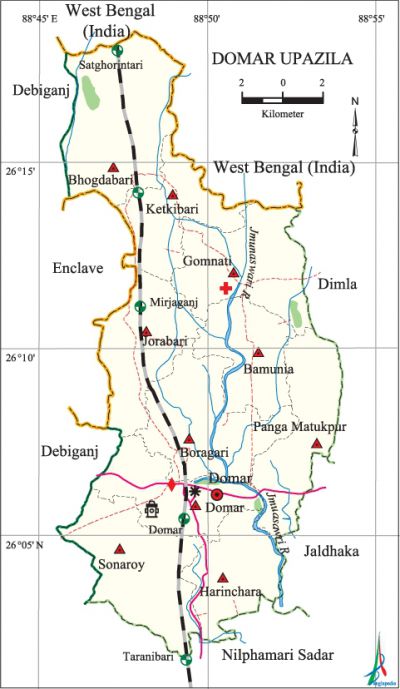Domar Upazila
Domar Upazila (nilphamari district) area 216.36 sq km, located in between 26°02' and 26°19' north latitudes and in between 88°46' and 88°54' east longitudes. It is bounded by west bengal of India on the north, nilphamari sadar upazila on the south, dimla and jaldhaka upazilas on the east, debiganj upazila on the west.
Population Total 249429; male 125338, female 124091; Muslim 203362, Hindu 45954, Buddhist 5, Christian 32 and others 76.
Water bodies Main rivers: Jamuneshwari, Buri Tista and Deonai.
Administration Domar thana was formed in 1875 and it was turned into an' upazila in 1984.
| Upazila | ||||||||
| Municipality | Union | Mouza | Village | Population | Density (per sq km) | Literacy rate (%) | ||
| Urban | Rural | Urban | Rural | |||||
| 1 | 10 | 47 | 47 | 40173 | 209256 | 1153 | 50.7 (2001) | 46.6 |
| Municipality | ||||||||
|
Area (sq km) |
Ward |
Mahalla |
Population |
Density |
Literacy rate (%) | |||
| 9.42 (2001) | 9 | 12 | 17027 | 1765 (2001) | 64.2 | |||
| Upazila Town | ||||||||
|
Area (sq km) |
Mouza |
Population |
Density (per sq km) |
Literacy rate (%) | ||||
| 21.48 (2001) | 4 | 23146 | 945 (2001) | 51.1 | ||||
| Union | ||||
| Name of union and GO code | Area (acre) | Population | Literacy rate (%) | |
| Male | Female | |||
| Ketkibari 76 | 4695 | 8916 | 8967 | 49.3 |
| Gomnati 47 | 7054 | 12855 | 12565 | 44.1 |
| Jorabari 66 | 5773 | 12084 | 11963 | 51.6 |
| Domar 38 | 4192 | 9728 | 9608 | 49.7 |
| Panga Matukpur 85 | 6034 | 11651 | 11125 | 42.1 |
| Bamunia 17 | 4810 | 8328 | 8091 | 49.0 |
| Boragari 28 | 7471 (2001) | 13814 | 13566 | 45.2 |
| Bhogdabari 19 | 9047 | 18259 | 18566 | 51.6 |
| Sonaroy 95 | 7053 | 12602 | 12763 | 43.3 |
| Harinchara 57 | 4807 | 8566 | 8385 | 43.4 |
Source Bangladesh Population Census 2001 and 2011, Bangladesh Bureau of Statistics.

Archaeological heritage and relics Mainamati Fort (Harinchara), Shah Kaland's Tomb (Sonaroy).
Historical events The peasants of this upazila, revolting against the British government and the local zamindars, declared Domar as an independent state in 1921. The Provincial Conference of the Krishak Sabha was held on 18 and 19 July 1942 in this upazila. Among the participants in this conference were Communist leader Jyoti Basu, peasant leaders Mansur Habibullah, Nripen Chakrabarti and others. Tebhaga Movement spread extensively in the area in 1946-1947.
War of Liberation In the end of April 1971 the people of the upazila marched towards Saidpur with 63 rifles and other indigenous weapons to attack Pak army Camp. However, they were forced to retreat. Freedom fighters had an encounter with the Pak army at Shialdangi of Ketakibari in August.
For details: see ডোমার উপজেলা, বাংলাদেশ মুক্তিযুদ্ধ জ্ঞানকোষ (Encyclopedia of Bangladesh War of Liberation), বাংলাদেশ এশিয়াটিক সোসাইটি, ঢাকা ২০২০, খণ্ড ৪।
Religious institutions Mosque 200, temple 50, tomb 7.
Literacy rate and educational institutions Average literacy 48.3%; male 51.4% female 45.2%. Educational institutions: College 5, technical college 4, agricultural college 1, secondary school 44, vocational school 3, madrasa 14. Noted educational institutions: Domar Multilateral High School (1919).
Cultural organisations Club 17, library 2, cinema hall 4, theatre group 1, theatre stage 1, women's organisation 1, cultural organisation 2.
Main sources of income Agriculture 68.04%, non-agricultural labourer 4.69%, industry 0.38%, commerce 12.38%, transport and communication 3.78%, service 4.28%, construction 0.97%, religious service 0.25%, rent and remittance 0.19% and others 5.04%.
Ownership of agricultural land Landowner 51.19%, landless 48.81%; agricultural landowner: urban 42.13% and rural 53.15%.
Main crops Paddy, jute, tobacco, potato, turmeric, ginger, onion, tomato, chilli and vegetables.
Extinct and nearly extinct crops Indigo, bhadai and aus paddy.
Main fruits Jackfruit, mango, black berry, banana, betel nut and litchi.
Communication facilities Roads: pucca 109.11 km, mud 560.10 km; railway 31.00 km; waterway 262.00 km. railway stations 3, bus stands 2.
Extinct or nearly extinct traditional transport Bullock cart.
Noted manufactories Rice mill, oil mill, saw mill, ice factory.
Cottage industries Bamboo work, bell-metal industry, blacksmith, potteries, wood work.
Hats, bazars and fairs Hats and bazars are 25, fairs 1, most noted of which are Basunia, Ambari and Boragari Hat.
Main exports Jute, ginger, potato, tomato, onion, betel nut.
Access to electricity All the wards and unions of the upazila are under rural electrification net-work; however, 33.5% dwelling households have access to electricity.
Natural resources There are coarse sand (Domar Sand) in this upazila.
Sources of drinking water Tube-well 95.2%, tap 0.6% and others 4.2%.
Sanitation 42.9% of dwelling households of the upazila use sanitary latrines and 40.7% of dwelling households use non-sanitary latrines; 16.4% of households do not have latrine facilities.
Health centres Upazila health complex 1, hospital 1, family welfare centre 10, clinic 1,' community clinic 10, satellite clinic 8, pathological centre 1.
Natural disasters The famine of 1943 caused huge loss of life in this upazila.
ngo activities' brac, asa, proshika, Peaceful Bangladesh Society. [Riasat Karim]
References Bangladesh Population Census 2001 and 2011, Bangladesh Bureau of Statistics; Cultural survey report of Domar Upazila 2007.
